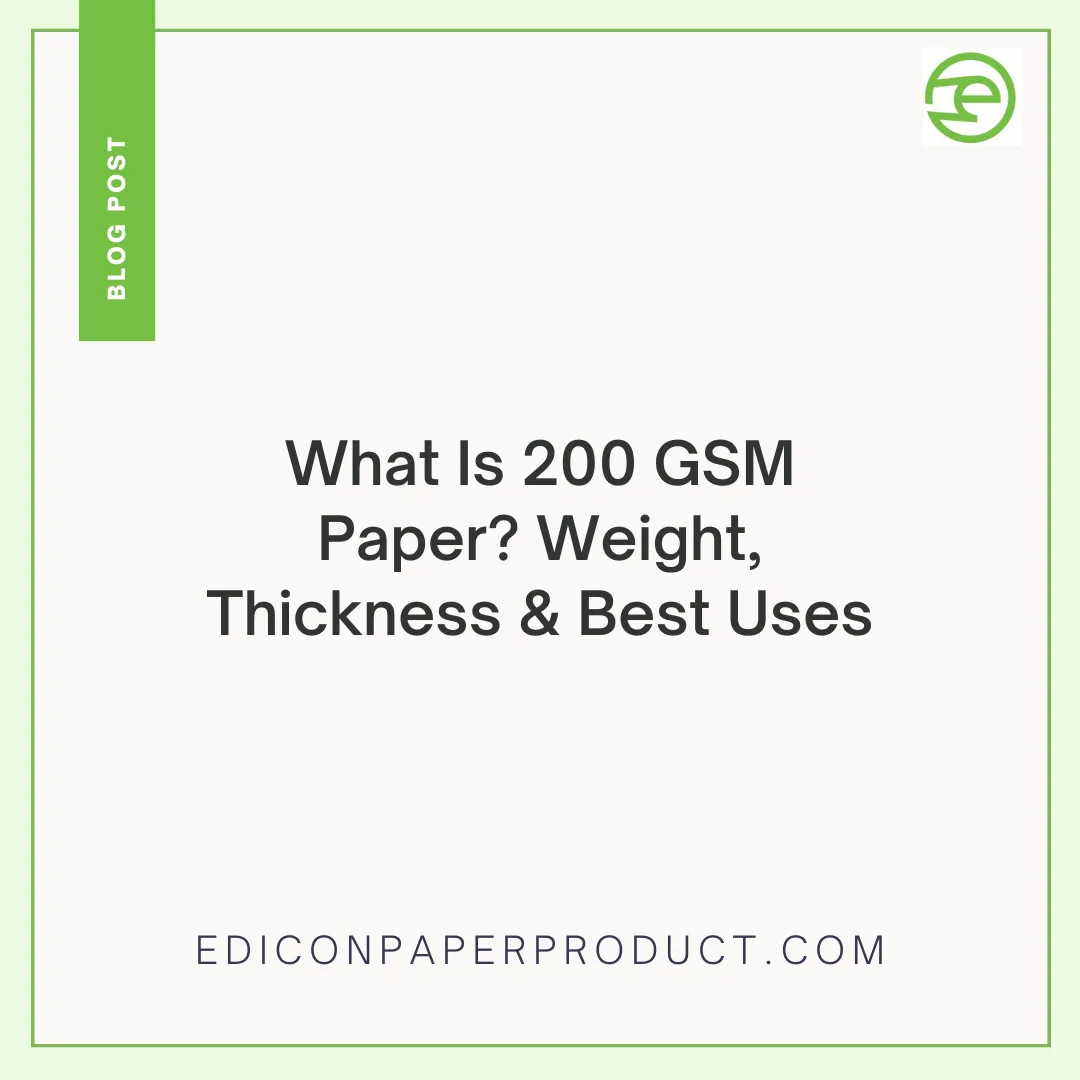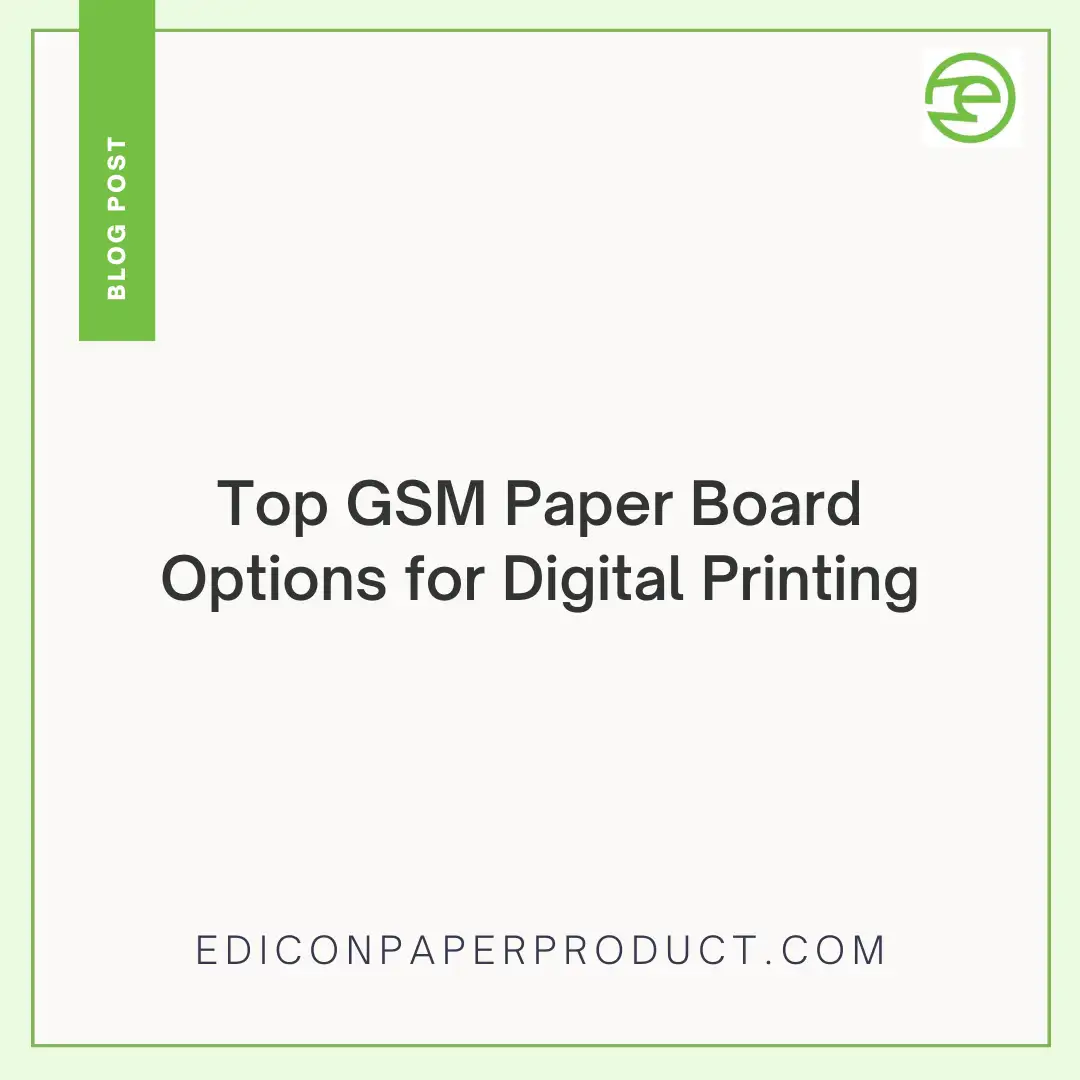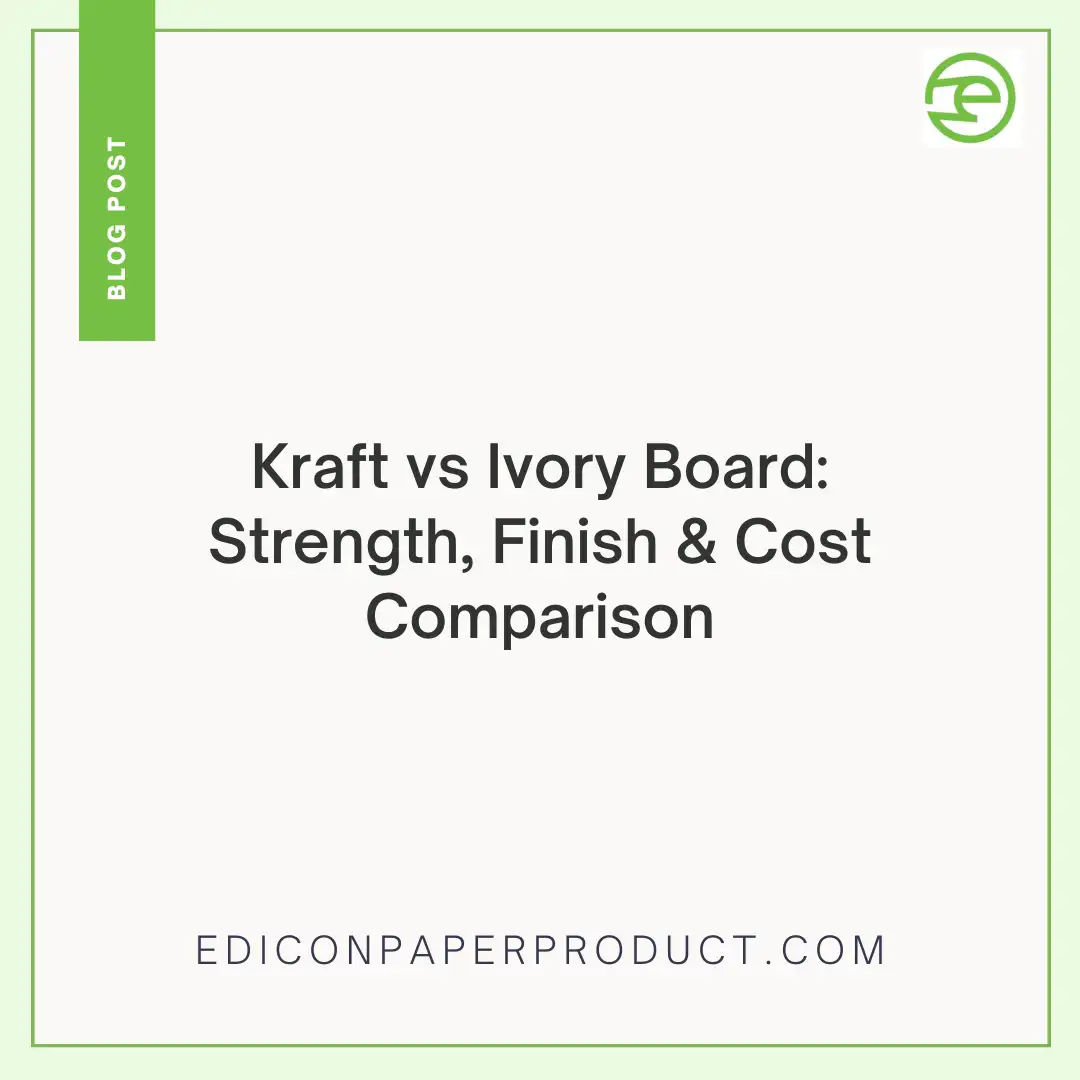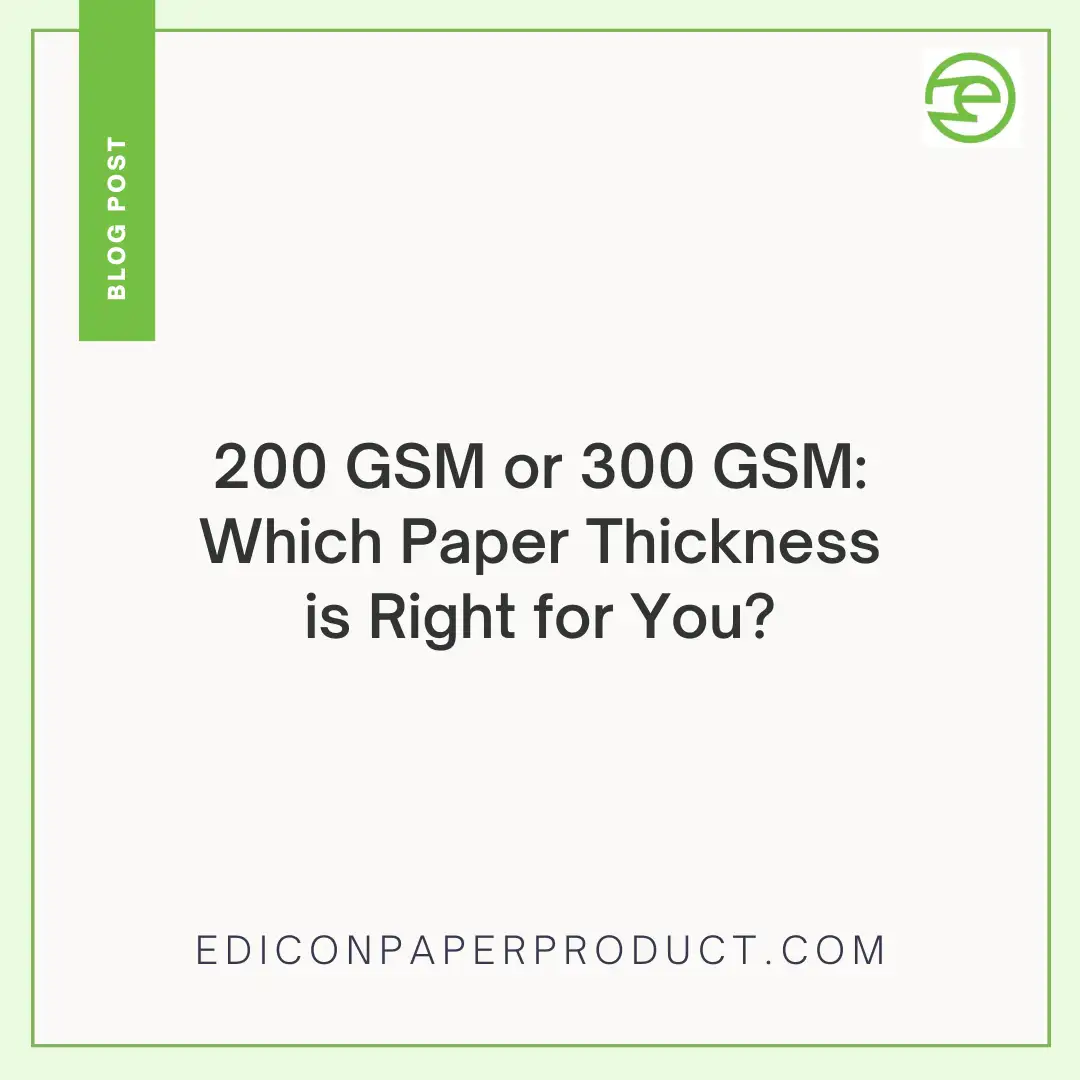What Is 200 GSM Paper? Weight, Thickness & Best Uses
So, you're trying to figure out paper weights for your next print job, huh? It can get a little confusing with all the different numbers and terms. We're going to talk about GSM, which is basically how we measure how heavy paper is. Think of it like this: heavier paper usually feels a bit more premium and holds up better. We'll be focusing on 200 gsm duplex board paper, which is a pretty common choice for a lot of things, and we'll break down what that actually means for your prints.
Key Takeaways
-
GSM, or grams per square meter, tells you how much a square meter of paper weighs, giving you an idea of its thickness and sturdiness.
-
200 gsm paper is considered a medium-to-heavy weight, often feeling like a thin card stock.
-
This weight is good for things like posters, brochures, and document covers because it's more durable than regular printer paper.
-
Higher GSM paper generally means better ink absorption and sharper prints, reducing issues like ink bleeding.
-
When choosing paper, think about what you're making and who will see it a business card needs different paper than a newspaper.
Understanding Paper Weight: The Role of GSM
Ever wonder why some printed materials just feel a bit flimsy, while others have that satisfying heft? A lot of that comes down to the paper's weight, and the standard way to measure that is with GSM. GSM stands for Grams per Square Meter. Basically, it's a way to figure out how much a one-square-meter sheet of paper weighs. The higher the GSM number, the heavier and usually thicker the paper is. It’s a pretty straightforward system, and it’s used all over the world, which is nice because it makes comparing different papers much easier.
What GSM Signifies in Paper
So, what does that number actually tell you? Well, it’s a direct indicator of the paper's density. Think of it like this: if you have two sheets of paper that are exactly the same size, the one with the higher GSM will weigh more. This extra weight usually means the paper is thicker, more durable, and often feels more substantial in your hands. It’s not just about weight, though; GSM also gives you clues about how the paper will perform when you print on it. Heavier papers generally handle ink better, leading to sharper images and less ink bleeding through to the other side. Lighter papers, on the other hand, are often more economical and better suited for things you need to print in large quantities.
GSM vs. Pounds: A Comparative Look
In the US, you might also see paper weight measured in pounds (lbs). This system can be a bit confusing because it’s not as straightforward as GSM. The pound measurement often refers to the weight of 500 sheets of paper, but the size of that original sheet can change depending on the paper type (like bond paper versus cover stock). This means 80 lb paper in one category might be a different thickness than 80 lb paper in another. GSM avoids this confusion entirely. It’s a direct measurement of the paper itself, making it a universal standard. So, while you might see both numbers, GSM is generally the more reliable way to compare paper weights directly.
Here's a quick look at how they can relate:
| GSM | Approx. LBS (Cover) |
|---|---|
| 150 | 65 lb |
| 175 | 80 lb |
| 215 | 100 lb |
| 270 | 130 lb |
How Paper Weight Impacts Print Quality
Paper weight really does make a difference in how your printed items turn out. For starters, heavier paper, like something in the 200 GSM range, feels more professional and durable. It’s less likely to bend or tear, which is great for things like business cards or brochures that get handled a lot. When it comes to ink, heavier papers usually have a smoother surface and absorb ink more evenly. This means your colors can look more vibrant, and text will be crisper. You’ll also notice less 'show-through,' where you can see the print from the other side of the page. Lighter papers, while cheaper and easier to mail in bulk, might not give you that same premium feel or the sharpest print results, especially with heavy ink coverage.
Exploring the Characteristics of 200 GSM Paper
![]()
The Feel and Durability of 200 GSM
So, what's the deal with 200 GSM paper? Think of it as a step up from your standard printer paper. It’s not super flimsy, but it’s not quite cardstock either. This weight gives it a nice, substantial feel in your hands. It’s sturdy enough that it won't easily bend or crease when you handle it, which is a big plus if you’re making something that needs to last a bit. You know, like a flyer that people might keep for a while, or maybe a booklet that gets passed around. It feels more professional than lighter papers, but it’s still flexible enough to be bound or folded without a problem. It’s a good middle ground, really.
Ink Absorption and Print Clarity
When it comes to printing, 200 GSM paper generally does a pretty good job. Because it's a bit thicker and denser than, say, 80 GSM paper, it tends to handle ink well. This means colors can look quite vibrant, and text usually comes out sharp. You're less likely to see ink bleed through to the other side, which is a common issue with thinner papers. This makes it a solid choice if you have designs with lots of color or fine details. It’s not quite the heavy-duty, super-smooth surface you might find on very high-end cardstock, but for most printing needs, it offers a good balance of clarity and ink retention. It’s a reliable option for getting your message across clearly.
200 GSM Paper as Thin Card Stock
People often think of 200 GSM as a type of thin card stock, and that’s a pretty accurate way to put it. It’s definitely thicker and more rigid than regular copy paper, but it’s not as stiff as the heavy cardstock used for things like premium business cards or thick invitations. You can easily fold it without it cracking, which is great for making things like greeting cards or small brochures. It has enough body to stand up on its own a little, but it’s still manageable for printing and cutting. If you need something that feels a bit more premium and durable than a standard flyer but doesn't need the rigidity of a postcard, 200 GSM hits that sweet spot. It’s a versatile weight that bridges the gap between paper and cardstock.
Applications Suited for 200 GSM Duplex Board Paper
![]()
So, you've got this 200 GSM paper, and you're wondering what to do with it. It's not super thin like regular printer paper, but it's not as thick as, say, a business card either. Think of it as that sweet spot in the middle. It's got a nice heft to it, making it feel a bit more substantial than your average flyer paper.
Ideal Uses for Medium-Weight Paper
This 200 gsm paper is pretty versatile. It's great for things that need to hold up a bit better than a flimsy brochure but don't need the rigidity of a postcard. We're talking about things like:
-
Booklets and Zines: If you're putting together a small publication, 200gsm white paper gives it a professional feel without making it too bulky. It handles folding well, too.
-
Menus: Restaurants often use paper in this weight range for their menus. It can withstand a bit of handling and occasional spills better than lighter options.
-
Greeting Cards: While some might go heavier for fancy invitations, 200gsm cardstock is perfectly fine for everyday greeting cards. It's sturdy enough to stand up on its own.
-
Flyers and Handouts: For promotional materials that you want to feel a bit more premium than a standard flyer, 200gsm paper makes a good impression.
Enhancing Visuals with 200 GSM
When you're printing images or designs, the weight of the paper really matters. A 200 gsm photo paper, for instance, can really make colors pop. Because it's a bit thicker, it doesn't soak up ink quite as much as lighter papers, which means your images tend to be sharper and more vibrant. This is especially true if you're using a coated duplex board, which gives the surface a smooth finish that's perfect for high-quality prints. You won't get that annoying show-through where you can see the print from the other side, which is a big plus for anything you want to look polished.
Durability for Everyday Items
Let's talk about durability. This gsm 200 paper is tough enough for items that get handled regularly. Think about things like:
-
Thank You Cards: These often get kept, so having a paper that feels substantial is a good idea.
-
Event Programs: For weddings or parties, the program needs to last through the event and maybe even be kept as a memento.
-
Postcards: While some postcards are printed on heavier stock, 200gsm is a solid choice for many, especially if they aren't being mailed without an envelope.
It's important to note that there are different types of duplex board. You might find duplex board grey back, which has a greyish backing, or other variations. The surface coating on duplex paper can also affect how ink sits on it. For example, a glossy coated duplex board will give a different finish than a matte one. If you're looking for something with a natural, rustic feel, 200 gsm kraft paper is also an option, though its texture might affect fine print clarity compared to smoother papers.
Understanding Duplex Board Paper
What Is Duplex Board?
Duplex board is a type of paperboard made with two layers: a top coated layer for printing and a grey or uncoated back. This dual-layer construction provides extra strength while allowing smooth, high-quality prints. Duplex board is widely used in packaging, promotional materials, and products that need both rigidity and aesthetics.
200 GSM Duplex Board
A 200 GSM duplex board combines the weight of medium cardstock with the rigidity of a board. It is perfect for packaging items that require sturdiness without being bulky. Common uses include:
-
Food Packaging: Boxes for chocolates, baked goods, and snacks.
-
Cosmetic Packaging: Sturdy yet elegant boxes for creams and perfumes.
-
Printing Projects: Brochures, promotional kits, and posters.
Coated vs. Uncoated Duplex Board
-
Coated Duplex Board: Has a glossy or smooth surface for sharp, vibrant printing. Ideal for high-end packaging and marketing materials.
-
Uncoated/ Grey Back Board: Provides a natural, matte look. Often eco-friendly and perfect for sustainable packaging.
Comparing GSM Weights for Different Print Projects
![]()
So, you've got a project in mind, and you're wondering about the paper. It's not just about how it looks, but how it feels and how it holds up. That's where GSM comes into play, and picking the right one can really make a difference. Think of it like choosing the right clothes for an occasion you wouldn't wear a t-shirt to a formal dinner, right? Paper is similar.
Lightweight Paper for Mass Distribution
When you need to get a message out to a lot of people, like with flyers or simple handouts, you usually want something that's easy on the wallet and easy to mail. Papers in the 50-80 GSM range are good for this. They're light, which means lower postage costs, and they're flexible enough to fold easily. They're not going to feel super fancy, but they get the job done for quick announcements or event promotions where the message is key, not the paper's heft.
Medium Weights for Booklets and Flyers
Stepping up a bit, we get into the medium weights, typically from 90 to 170 GSM. This is a sweet spot for a lot of common print jobs. Think magazines, brochures, and even some types of posters. This paper has a bit more substance than the super-light stuff. It feels more durable, and it handles ink pretty well, giving you clearer images and text without too much show-through from the other side. It strikes a good balance between quality and cost, making it a popular choice for things people will hold onto for a little while.
Heavyweights for Premium Business Cards
Now, if you want to make a real impression, especially for things like business cards, invitations, or even covers for reports, you're looking at the heavier end, usually 200 GSM and up. This paper feels substantial. It's sturdy, it doesn't bend easily, and it gives a real sense of quality. When you hand someone a business card printed on 200 GSM or heavier stock, it just feels more professional and memorable. It also means your ink won't bleed through, and colors will look richer. It’s an investment, sure, but for items that represent you or your brand, it’s often worth it.
Here’s a quick look at how different GSM weights generally stack up:
| GSM Range | Typical Use Cases |
|---|---|
| 50-80 GSM | Newspapers, simple flyers, inserts |
| 90-120 GSM | Book pages, magazines, posters |
| 130-170 GSM | Brochures, flyers, light cardstock |
| 200-300 GSM | Business cards, invitations, postcards, covers |
| 300+ GSM | Premium business cards, packaging, high-end stationery |
Choosing the right paper weight isn't just about following a trend; it's about making sure your printed material communicates the right message. A heavier paper often signals importance and durability, while a lighter paper is more practical for widespread distribution. It's a subtle but significant detail that can affect how your audience perceives your work.
For businesses and printers looking for reliable options, Edicon Paper, a leading duplex board manufacturer and supplier, offers a wide range of GSM options, including 200 GSM and beyond, catering to diverse printing, packaging, and stationery needs with consistent quality and strength.
Making Informed Paper Choices
So, you've been looking at paper weights, maybe for flyers, maybe for a booklet, and you're wondering how to actually pick the right one. It's not as complicated as it sounds, honestly. Think about what you're making and who's going to see it. That's really the main thing.
Matching GSM to Project Purpose
Different jobs need different paper. You wouldn't use the same paper for a wedding invitation as you would for a newspaper insert, right? For things that need to last or make a good impression, like business cards or reports, you'll want something with a bit more heft. That's where papers in the 200-300 GSM range often come in. They feel substantial and look professional. For items that are handed out a lot or mailed in bulk, like flyers or brochures, a lighter weight might be better. It keeps costs down and makes them easier to handle. For example, 40 lb paper (around 60 GSM) is often used for posters or lightweight booklets.
The Importance of Paper Finish and Opacity
Beyond just weight, the finish and opacity of the paper play a role too. A glossy finish might make photos look vibrant, but it can also cause glare. A matte finish is often better for text-heavy documents because it's easier on the eyes. Opacity is basically how much you can see through the paper. Higher GSM papers usually have better opacity, meaning less 'show-through' from the other side.
This is super important for double-sided printing. When you're trying to decide, it's always a good idea to get paper samples if you can. Seeing and feeling the paper yourself is the best way to make sure it fits your project. You can find guides that help compare different weights, like this one on paper weight and thickness.
Wrapping It Up
So, when you're picking out paper, remember that GSM is a pretty big deal. It's not just about how thick the paper feels, but also how it handles ink, how durable it is, and honestly, how professional your final print looks. For things like posters or brochures, that 200 GSM sweet spot gives you a nice balance sturdy enough for good color but not so heavy it's awkward. But really, the best GSM always comes down to what you're making. Think about your project, who it's for, and what you want it to feel like. Getting the paper weight right can make a surprisingly big difference.
Frequently Asked Questions
What does GSM mean for paper?
GSM stands for grams per square meter. It's a way to measure how heavy or thick a piece of paper is. Think of it like this: if you took a sheet of paper that was exactly one meter long and one meter wide, its GSM would be how much that sheet weighs in grams. A higher GSM number means the paper is heavier and usually thicker.
Is 200 GSM paper considered thick or thin?
Two hundred GSM paper is in the middle range. It's not super thin like the paper you use for everyday printing, but it's also not as thick as the cardstock used for business cards. It's often called a 'thin card stock' or a medium-weight paper. It feels sturdy enough for things like posters or covers but is still flexible enough to fold easily.
What kind of things is 200 GSM paper good for?
This type of paper is great for many things! It's often used for making posters, brochures, flyers, and even covers for booklets or reports. Because it's a bit thicker than regular paper, it can handle more ink without the colors looking dull or the ink bleeding through to the other side. It gives a more professional and durable feel compared to lighter papers.
How does paper weight (GSM) affect printing?
The weight of the paper, measured in GSM, really matters for printing. Heavier papers, like 200 GSM, usually have a smoother surface and absorb ink better. This means your printed pictures and text will look sharper and more colorful. Lighter papers might let ink soak through or look less vibrant, especially with lots of color.
What is the difference between 200 GSM and 300 GSM paper?
300 GSM paper is thicker, heavier, and more rigid. It is ideal for luxury packaging, hardcover projects, or high-end invitations, while 200 GSM is versatile for general-purpose printing and packaging.
Can I use 200 GSM paper for double-sided printing?
Yes. 200 GSM is thick enough to prevent ink bleed-through, making it suitable for double-sided printing on documents and promotional materials.






